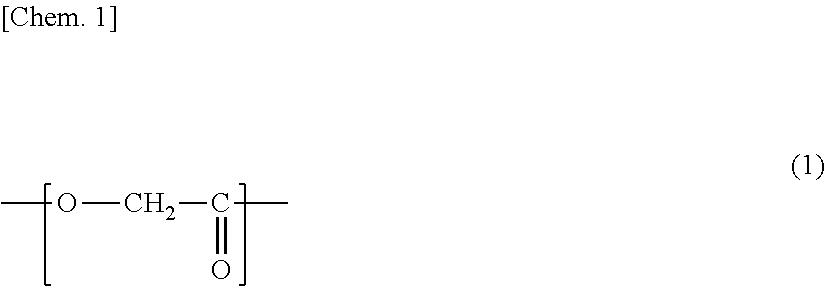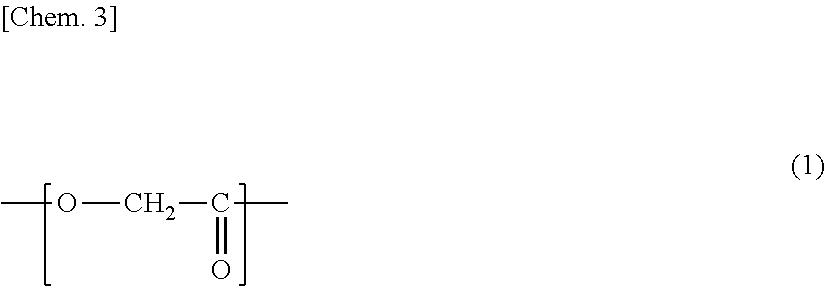Sequentially Biaxially-Oriented Polyglycolic Acid Film, Production Process Thereof and Multi-Layer Film
a polyglycolic acid film, sequential biaxial orientation technology, applied in the direction of synthetic resin layered products, packaging, etc., can solve the problems of plastic waste disposal becoming a great problem, polyglycolic acid generally insufficient melt stability, and insufficient heat dissipation stability, etc., to achieve excellent gas barrier properties, mechanical strength, transparency and resistance to heat shrinkage, excellent gas barrier properties
- Summary
- Abstract
- Description
- Claims
- Application Information
AI Technical Summary
Benefits of technology
Problems solved by technology
Method used
Image
Examples
example 1
[0132]Raw pellets of PGA-1 were heated and melted by means of a single-screw extruder having a screw diameter of 35 mm so as to give a resin temperature of 260 to 270° C. The resultant melt was caused to pass through a filter having a pore size of 100 μm and extruded from a T-die having a linear lip having a length of 270 mm and an interstice of 0.75 mm and cast on a metal drum kept at a surface temperature of 40° C., thereby cooling the extrudate to prepare an unstretched sheet having a thickness of 200 μm.
[0133]The unstretched sheet controlled to a sheet temperature of 60° C. was uniaxially stretched in a machine direction (MD) at a stretching speed of 2 m / min by means of stretching rolls so as to give a draw ratio of 6.0 times (Step 1).
[0134]The resultant uniaxially oriented film was then cooled for about 15 seconds by means of a spot cooler and a cooling roll in such a manner that the surface temperature of the film is 33° C. (Step 2).
[0135]The uniaxially oriented film was then ...
example 2
[0138]A sequentially biaxially-oriented film was prepared in the same manner as in Example 1 except that the operation conditions in Steps 1 to 4 were changed to conditions shown in Table 1. The operation conditions and results are shown in Tables 1 and 2.
example 3
[0139]A sequentially biaxially-oriented film was prepared in the same manner as in Example 1 except that the operation conditions in Steps 1 to 4 were changed to conditions shown in Table 1. The operation conditions and results are shown in Tables 1 and 2.
PUM
| Property | Measurement | Unit |
|---|---|---|
| stretching temperature | aaaaa | aaaaa |
| stretching temperature | aaaaa | aaaaa |
| stretching temperature | aaaaa | aaaaa |
Abstract
Description
Claims
Application Information
 Login to View More
Login to View More - R&D
- Intellectual Property
- Life Sciences
- Materials
- Tech Scout
- Unparalleled Data Quality
- Higher Quality Content
- 60% Fewer Hallucinations
Browse by: Latest US Patents, China's latest patents, Technical Efficacy Thesaurus, Application Domain, Technology Topic, Popular Technical Reports.
© 2025 PatSnap. All rights reserved.Legal|Privacy policy|Modern Slavery Act Transparency Statement|Sitemap|About US| Contact US: help@patsnap.com



